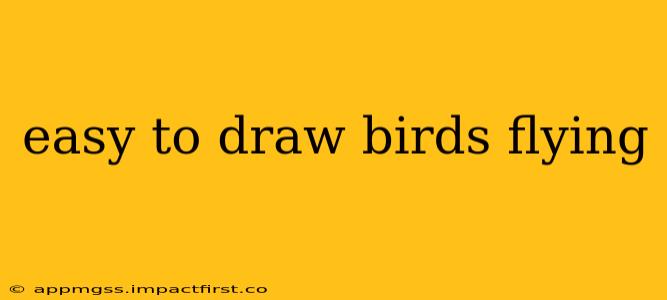Learning to draw birds in flight can seem daunting, but with a few simple steps and techniques, even beginners can create beautiful and realistic-looking flying birds. This guide will break down the process into manageable parts, focusing on simplicity and ease of execution. We'll explore different bird shapes and flying positions, making it accessible for all skill levels.
What Supplies Do I Need to Draw Flying Birds?
Before we begin, let's gather our materials. You don't need anything fancy! All you'll need is:
- Paper: Any type of paper will work, but smoother paper is generally easier to draw on.
- Pencil: A regular HB pencil is perfect for sketching. You can use a darker pencil for outlining later.
- Eraser: To correct mistakes and refine your drawing.
- Optional: Colored pencils, markers, or paints: To add color and detail to your finished drawing.
How to Draw a Simple Flying Bird: Step-by-Step
This method focuses on creating a basic bird shape, perfect for beginners.
-
Start with a teardrop shape: Draw a slightly elongated teardrop shape. This will form the body of your bird.
-
Add the wings: Extend two curved lines from the sides of the teardrop, creating the wings. Make them slightly asymmetrical for a more natural look.
-
Draw the head: Add a small circle or oval at the top of the teardrop for the head.
-
Sketch the beak and tail: Draw a small triangle for the beak and a few feathery lines extending from the bottom of the teardrop for the tail.
-
Add details: You can add simple details like eyes, claws, and wing feathers to personalize your bird.
-
Refine and erase: Use your eraser to clean up any unnecessary lines and refine the shapes.
-
Add color (optional): Once you're happy with your pencil sketch, you can add color using your preferred medium.
How to Draw Different Types of Birds in Flight?
While the basic teardrop shape works for many birds, different species have distinct characteristics.
-
Swallows and Swifts: These birds have long, pointed wings and a slender body. Emphasize the length of their wings and their streamlined shape.
-
Eagles and Hawks: These birds have broad wings and a powerful body. Focus on the size and shape of their wings, showing their ability to soar.
-
Hummingbirds: These tiny birds have incredibly fast wingbeats. You can suggest this motion by blurring the wings slightly or drawing a series of slightly different wing positions.
What are Some Tips for Drawing Birds in Motion?
Drawing birds in flight involves capturing movement. Here are some helpful tips:
-
Observe real birds: Watching real birds fly is the best way to understand their movement and shapes. Pay attention to how their wings move and how their bodies position themselves.
-
Focus on the overall shape: Don't get bogged down in tiny details. Start with the overall shape of the bird and its wings, then add details later.
-
Use light and shadow: Adding shading can help give your drawing depth and dimension, making it more realistic.
-
Practice, practice, practice: The more you practice, the better you'll become at drawing birds in flight.
What are the Basic Shapes of Birds in Flight?
The fundamental shapes often used to depict birds in flight are variations of teardrops, elongated ovals, and dynamic curves. Understanding these base shapes significantly simplifies the process.
What are Some Easy Bird Poses to Draw?
Starting with simpler poses, such as a bird gliding horizontally or a bird taking off, can be easier than attempting complex maneuvers. Focus on clear lines and simple shapes first.
How Can I Make My Bird Drawings More Realistic?
Adding details like precise feather patterns, accurate beak shapes, and considering the bird's posture relative to its flight dynamics significantly improves realism. Observing real-life reference photos or videos is highly recommended.
By following these steps and practicing regularly, you'll be surprised at how quickly you improve your ability to draw birds in flight. Remember, the key is to have fun and experiment! Don't be afraid to try different techniques and styles until you find what works best for you.
